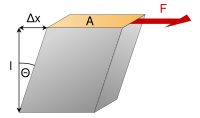
Photo from wikipedia
The evaluation of the mechanical properties of a transversely isotropic rock mass is a challenging task in practical engineering. This paper aims to study the relationships between the integrity parameters… Click to show full abstract
The evaluation of the mechanical properties of a transversely isotropic rock mass is a challenging task in practical engineering. This paper aims to study the relationships between the integrity parameters and mechanical properties of a transversely isotropic rock mass. The rock mass quality designation (RQD) is an important index and reference for rock mass quality evaluation that was introduced to establish the numerical models of a jointed rock mass with different integrities. The numerical models of a transversely isotropic rock mass were established using the bonded particle model (BPM) and smooth joint model (SJM) embedded into the Particle Flow Code software (PFC 2D ). After calibrating the microscopic parameters of the intact rock and structural planes, a series of compression tests of a transversely isotropic rock mass was carried out to determine compressive strength and deformation modulus, and main factors were considered including the RQD, inclined angle of structural planes, structural plane thickness, structural plane properties, intact rock properties, and confining pressure. The experimental results showed that the mechanical parameters and failure modes of a transversely isotropic rock mass were controlled by the integrity parameters. By comparing the value of σ cm /σ c (ratio of the compressive strength of rock mass to rock mass) and E m /E r (ratio of the deformation modulus of rock mass to rock mass) with field test results, the results obtained from the discrete element method were demonstrated to be reasonable.
Journal Title: Bulletin of Engineering Geology and the Environment
Year Published: 2019
Link to full text (if available)
Share on Social Media: Sign Up to like & get
recommendations!